Near Earth fly by of asteroid 2011 MD on June 27, 2011
| Frameless version of this page |
Discovery and discription of asteroid 2011 MD
Ephemerides and orbital data of asteroid 2011 MD
Astrometry with position determinations of asteroid 2011 MD
Photometry with determination of the rotation period of asteroid 2011 MD
Videos from the CCD images show the rapid movement of asteroid 2011 MD
Technical setup of astronomy equipment for CCD imaging
Asteroid 2011 MD
Soon after the discovery and the reporting of position data from station 704 to the Minor Planet Center (MPC) an orbit calculation of object 2011 MD was possible. Now it was clear that this object would not hit the Earth but it would fly by in a distance of only 12.280 kilometers to the surface of Earth on June 27, 2011 at about 17:00 UTC. For a short time the possibility of an artifical object came in discussion. But soon after more calculations the natural origin of 2001 MD was confirmed with a high probability.
The ephemerides table below was calculated with the Minor Planet & Comets Ephemeris Service exactly for the MPC station C47 Nonndorf on Position 15.2356° East, 48.7871° North and 547m MSL. However such a table can be used in a radius of several hundred kilometers if the object is in a distance of more than 100.000 kilometers. The position movement caused by the parallax would not be too big in this case. But if an object would came within a distance of only few 10.000 of kilometers the position error would rise too much and the object could not be surely located on the sky.
Because of the orbit data of 2011 MD it was clear that for a location in Europe only one really good observation night for the fly by observation would exist. This was the night from June 26 to 27, 2011. The asteroid reached a motion on sky of about one arcsecond in one time second. This corresponds to about two moon diameter in one hour. The distance of 2011 MD was still in a range of 200.000 to 180.00 kilometers and the brightness about +16mag. The near Earth fly by about 15 hours later was only observable on the southern hemisphere. During this time the object reached a sky motion of about 70 arcseconds in one time second and a brightness of +11.4mag. So on northern hemisphere only CCD cameras were useful for the capture of position images of the object. On southern hemisphere beside CCD also an appropriate video technic with Video Time Inserter could be used for capturing fast sequences of object position data.
For astrometric evaluation of CCD images the excellent software Astrometrica was created by Herbert Raab. And for astrometric evaluation of video recordings with time insertion the very fine software Tangra was created by Hristo Pavlov. With Tangra positions of fast moving objects can be calculated from video frames in the same accuracy like position of slow moving objects from CCD images.
Ephemerides- and visibility table of 2011 MD for MPC station C47
Because of the near Earth fly by in June 2011 the orbit data of the small mass asteroid 2011 MD had changed very clearly. Due to this very small fly by distance for the first time the real non spheric shape of the Earth had to be used for accurate calculation of the gravitational impact on asteroid 2011 MD path change. To show this orbit change both data sets are presented here for direct comparison. And below this both orbits are shown in diagrams too. So the asteroid 2011 MD is on a very different orbit since June 2011. And the orbit will change ongoing because of gravity interactions with other objects and because of radiation influence by the sun.
Although this object will repeatly came in the nearness of Earth because of the orbit shape an another near Earth passage like in the year 2011 is not viewable at the moment. In this century another twelve near encounter will happen. And the nearest of this on June 21, 2086 will be in a distance of more than one million kilometers.
The approximately 5 to 15 meter sized asteroid 2011 MD was discovered on CCD images exposured on June 22, 2011 by the Lincoln Near Earth Asteroid Research (LINEAR) in Socorro - New Mexico. The station code 704 is assigned to this LINEAR system by the Minor Planet Center (MPC). The first images of 2011 MD were made on a telescope with an aperture of 1 meter and 2.5 meters focal length. At the discovery time this small asteroid was still 860.000 kilometers from Earth and a dim object of +19mag. This is about a factor of 500.000 too faint to be observable with the naked eye. But during the fly by this object would have been also too faint for an observation with binoculars.
June 26 - June 30, 2011
2011 MD - orbital data before Earth fly by in June 2011
Equinox Y2000.0
Epoch of orbital elements June 22, 2011
Period of orbit 1.050 years
Perihelion distance 1.0060764 AU
Aphelion distance 1.0498338 AU
Semimajor axis a 1.027955 AU
Exccentricity e 0.0212837
Inclination i 3.04208 degrees
Argument of perihelion 240.68512 degrees
Longitude ascending node 96.41772 degrees
Mean Anomaly 295.14409 degrees
Absolute magnitude H 28.10
Slope parameter G 0.15
2011 MD - orbital data after Earth fly by in June 2011
Equinox Y2000.0
Epoch of orbital elements July 12, 2011
Period of orbit 1.099 years
Perihelion distance 1.0160681 AU
Aphelion distance 1.1036759 AU
Semimajor axis a 1.0598720 AU
Exccentricity e 0.0413294
Inclination i 2.57237 degrees
Argument of perihelion 4.67671 degrees
Longitude ascending node 274.02421 degrees
Mean Anomaly 10.08041 degrees
Absolute magnitude H 28.10
Slope parameter G 0.15
The orboit position of asteroid 2011 MD in the solar system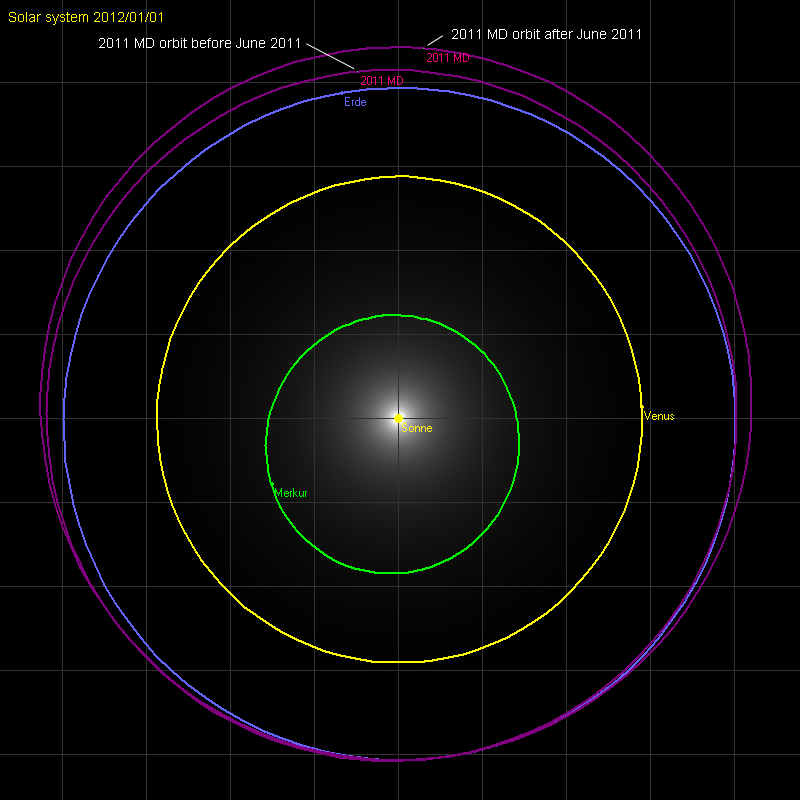 |
| The different orbits are clearly visble in the diagram above. This snap-shot of the solar system on January 01, 2012 shows that the asteroids orbit peroid is really longer as it was before the near Earth fly by in June 2011. And until the year 2020 this difference in positions will have rised up to a half of an orbit. |
The orbits of asteroid 2011 MD relative to the orbit of Earth |
| Diagrams created with EasySky from Matthias Busch |
Astrometry of 2011 MD
(MPC station C47 - Nonndorf)
| To obtain astrometric data of object 2011 MD overall 1069 CCD images were exposured in Nonndorf (C47) in the night from June 26, to June 27, 2011 from 22:06 to 00:36 UTC. The camera used was an Atik 314L+ and exposure time was 5 seconds. The optic was a 10 inch Newton telescope with a focal length of 1200mm (f4.8). In this way the object with a brightness of about +16mag could be imaged in an useable signal/noise ratio. And the number of useable reference stars needed for astrometry was also big enough. Longer exposure times would have lead to bad position data because of the object motion of about one arcsecond per time second. Because of the permanent movement of all solar system objects one has to find always a compromise between a good SNR and an exposure time as short as possible. |
CCD image of 2011 MD on June 26, 2011 at 23:53:40.9 UTC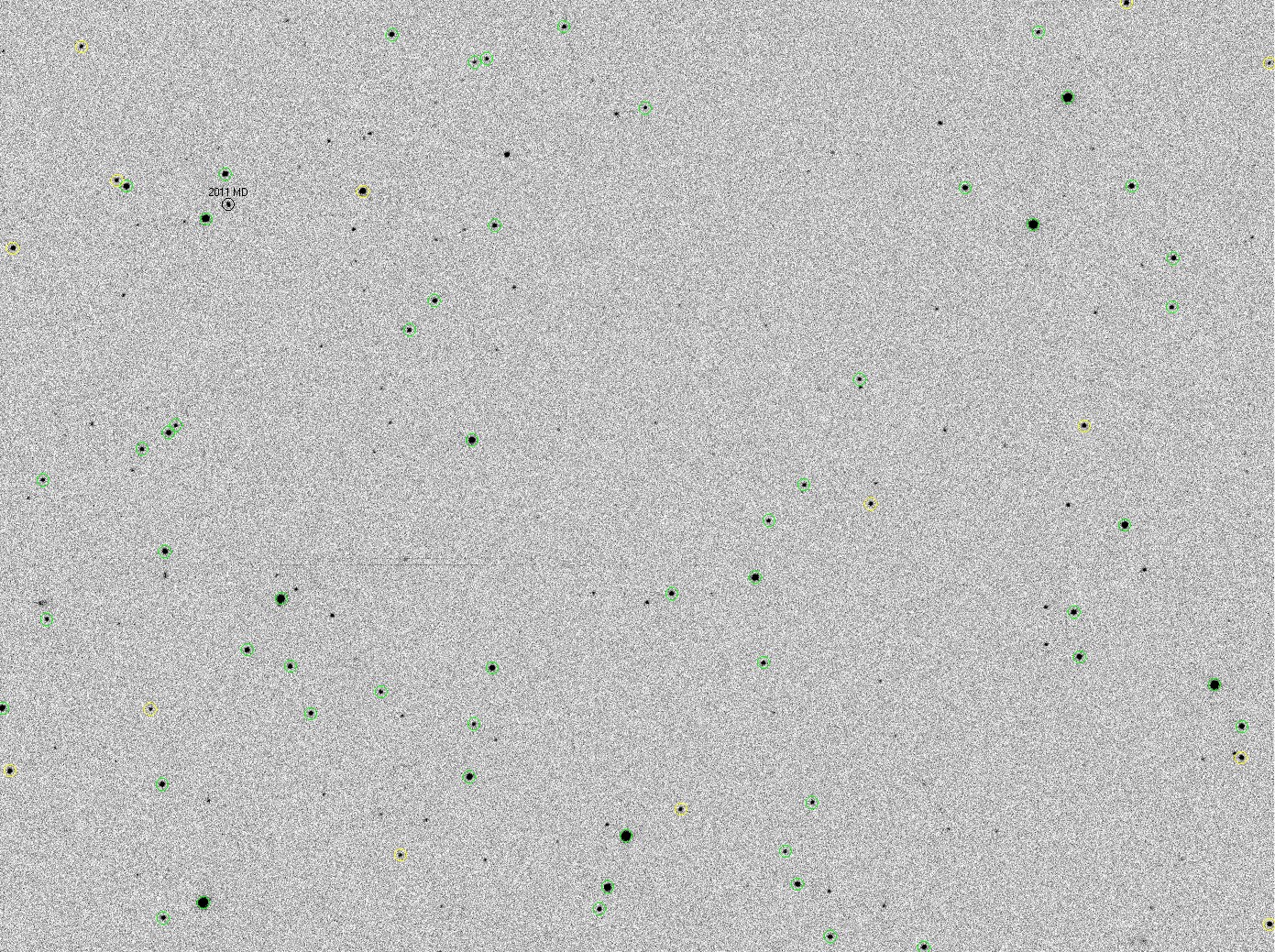 The asteroid 2011 MD was measured at position RA 16 05 14.10, DEC +28 32 53.2 (Y2000) in this image exposured in Nonndorf (C47). CCD Atik 314L+ @-10°C, 1391 x 1039, bin1x1, It=5s |
In this CCD image 56 reference stars could be used for astrometry |
Astrometry of asteroid 2011 MD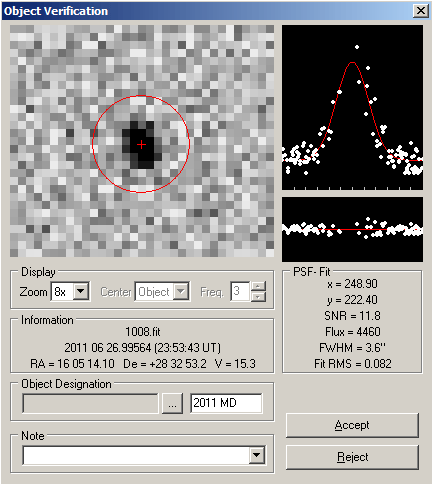 |
This six position data sets from June 26, 2011 were sent from station C47 to the Minor Planet Center.
COD C47
CON G. Dangl, Nonndorf 12, 3830, Austria [gerhard@dangl.at]
OBS G. Dangl
MEA G. Dangl
TEL 0.25-m f/4.8 reflector + CCD
ACK MPCReport file updated 2011.06.27 16:40:10
AC2 gerhard@dangl.at
NET UCAC-3
K11M00D C2011 06 26.92132 16 10 46.58 +29 43 39.2 15.4 V C47
K11M00D C2011 06 26.95934 16 07 56.71 +29 09 43.0 15.6 V C47
K11M00D C2011 06 26.98294 16 06 10.80 +28 46 16.3 15.9 V C47
K11M00D C2011 06 26.99564 16 05 14.10 +28 32 53.2 15.2 V C47
K11M00D C2011 06 27.01210 16 04 01.25 +28 14 43.5 15.1 V C47
K11M00D C2011 06 27.02435 16 03 07.59 +28 00 36.1 15.8 V C47
----- end -----
This 6 positions sent to the MPC are only a small part of more than 1000 positions collected from asteroid 2011 MD in this night by station C47. But they are representing about 0.4% of a total of 1527 positions for 2011 MD used on Near Earth Objects - Dynamic Site (NEODyS).
The astrometry was realized with Astrometrica from Herbert Raab.
Photometry of 2011 MD to determine the rotation period
| Even within a small number of CCD images a change in brightness of 2011 MD was observable. Obviously the asteroid body rotated several times within one hour. So two CCD image sequences from different star fields with binning 1x1 were used for photometry too beside astrometry. Because only the rotation periode should be determined the relative brightness values should be sufficient. The data points below are from the two CCD image sequences exposured in different star fields. |
Evaluation of relative brightness variation of 2011 MD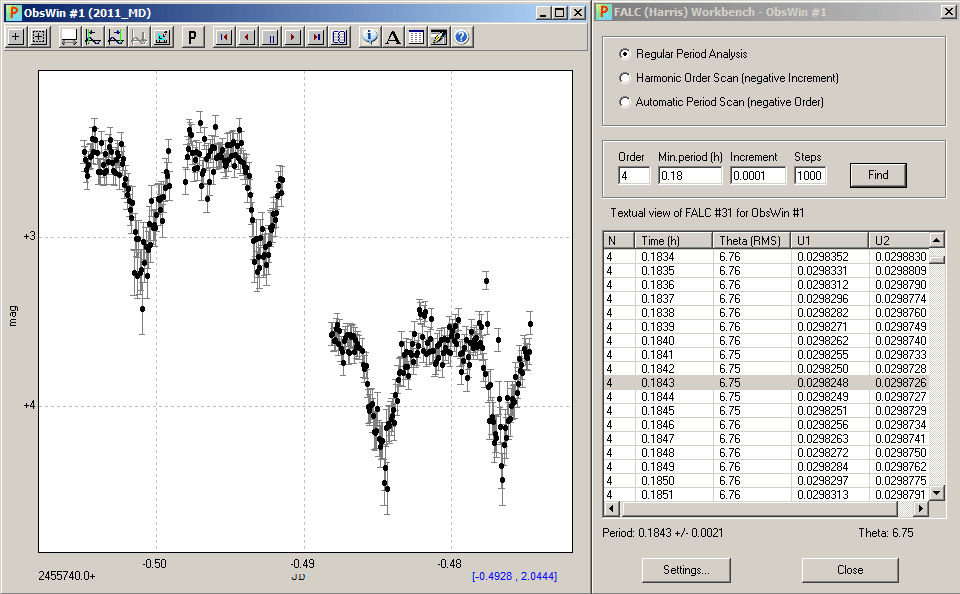 |
| The evaluation of this CCD image sequences with binning 1x1 was made with MPO software Canopus Version 10 from Brian D. Warner. The obtained data points with error values were analyzed with lightcurve and periode analyze software Peranso 2.50 from Tonny Vanmunster. The period of the asteroid rotation was searched with FALC methode, developed by Dr. Alan W. Harris (JPL). |
| With this relative brightness data from CCD binning 1x1 only one periodic cycle with a duration of 0.1843h ± 0.0021h could be found. This equates to 11 minutes and 3.5 seconds. But with a more accurate evaluation with more data points it was shown later very clear that this time value is only the half rotation cycle of 2011 MD. |
| Photometry with absolute brightness values and more data points |
| Beside the lightcurve above with relative brightness data a second analysis with much more data points consisting of 1x1 and 2x2 binning images was made. All absolute brightness values from this images were determined with Astrometrica. Bad data points due to nearby star disks on asteroid path were rejected manually. Astrometrica always writes a second file with photometric data beside the astrometric data file. From this photometric file brightness curves with absolute values can be created. The accuracy is good enough to show the brightness change and curve shape caused by an object in rotation.
In cooperation with Rolf Apitzsch from MPC station 198 in Wildberg (DE) also the data points with ObsCode 198 could be used in the evaluation. Now overall 1273 data points for a time span of 0.1221 days or 176 minutes were available. With this additional data points a longer time span was available for evaluation. And a good conformance between the data ponts from station 198 Wildberg and station C47 Nonndorf was visible too. Both measurement data rows leaded to the same rotation period result if used individual or combined. |
Evaluation of absolute brightness changes of 2011 MD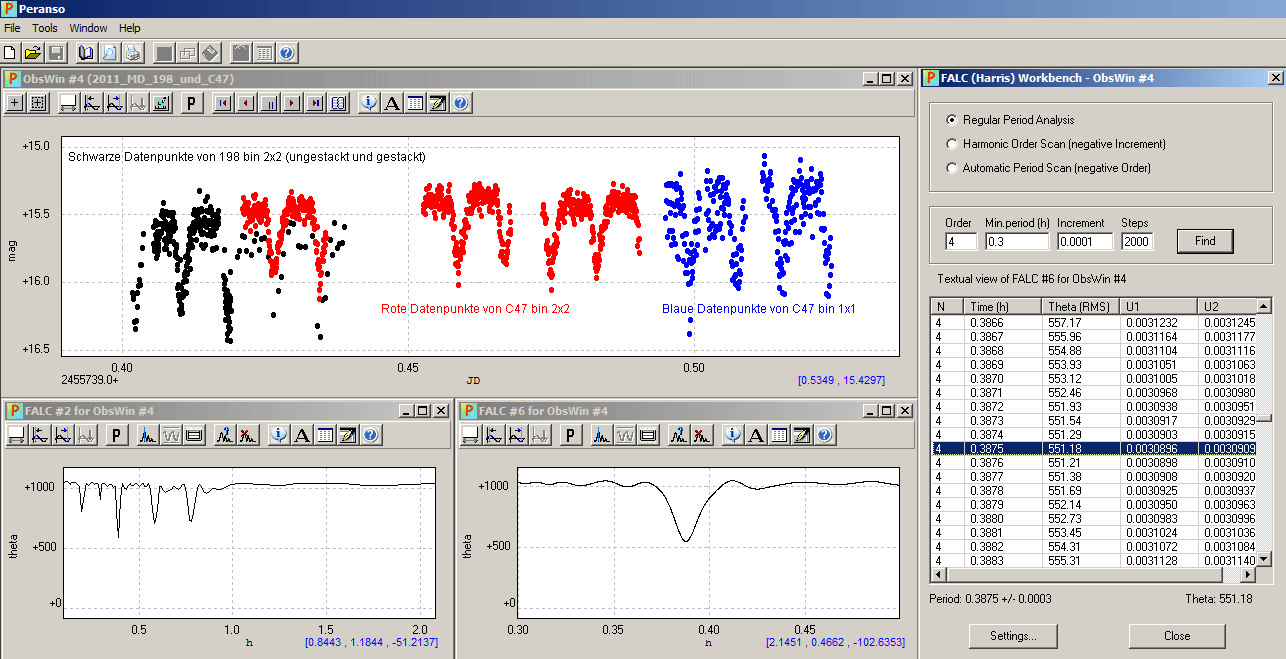 |
| The photometric evaluation of the CCD exposure sequences was realized with astrometry software Astrometrica from Herbert Raab. The obtained absolute brightness values were analyzed with lightcurve and periode analyze software Peranso 2.50 from Tonny Vanmunster. The period of the asteroid rotation was searched again with FALC methode, developed by Dr. Alan W. Harris (JPL). |
| Like in the evaluation above the value of a half rotation period was found here again as one dominant value. But because two nearly similar minima with different peak values were visible here it was clear that the overall rotation period must be about the time span of two minimas. So in this time range the real period had to be searched. And in fact a rotation period of 0.3875 hours and a theta of 551.18 could be determined. |
Period duration and phase evaluation of 2011 MD |
| Result of rotation measurement of object 2011 MD T = 0.01615 days f = 61.94 rotations per day |
Diagram of 1273 data points within a time span of 176 minutes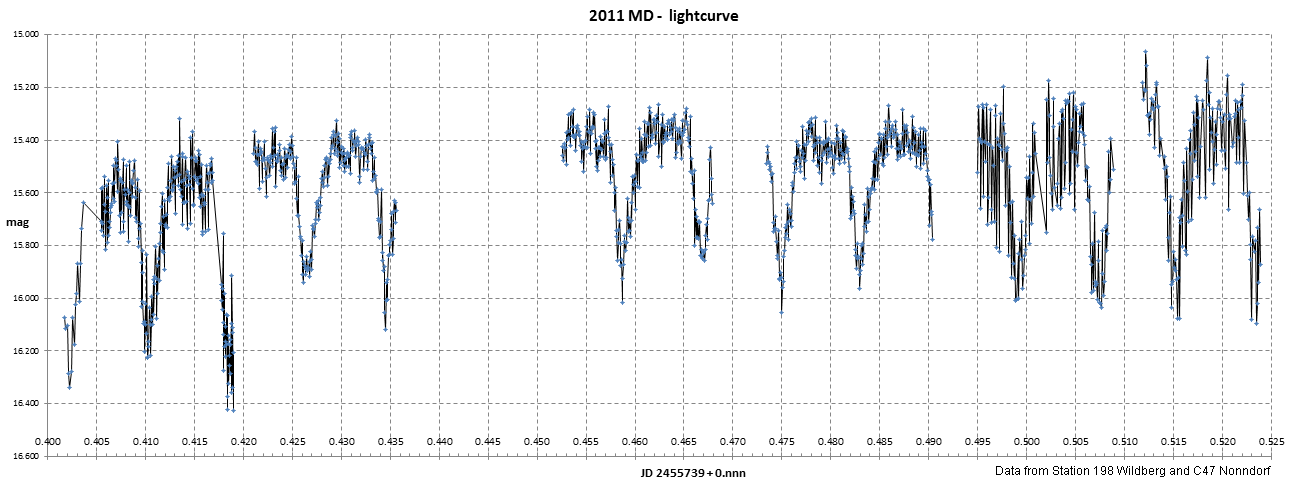 |
Equipment setup for CCD imaging of asteroid 2011 MD
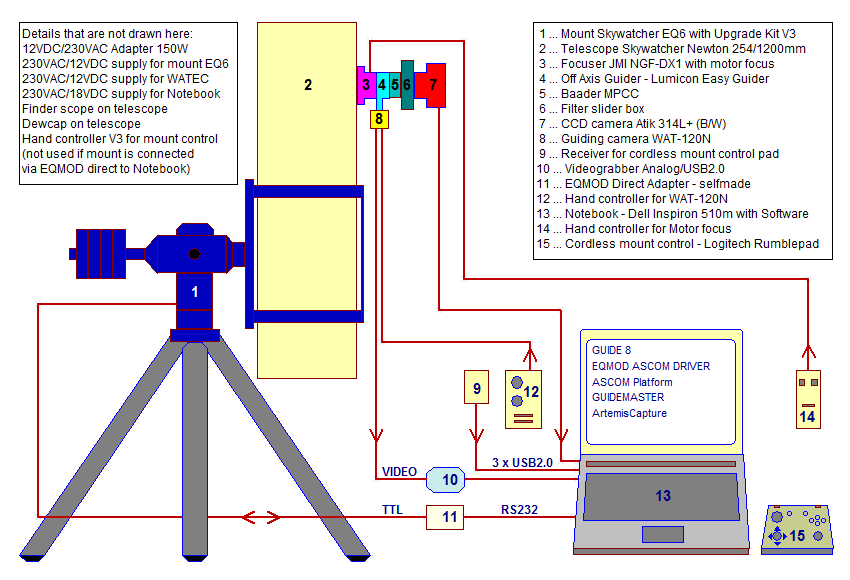
© 2011 G. Dangl
Top of page
July 27, 2011 |
|
Site Home |